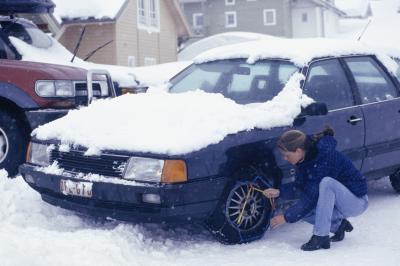
Tires specifically created for winter driving are commonly known as snow tires. They are formulated to have better traction in cold temperatures than standard tires and work better in snow, ice or slush. Tire chains are literally chains that go around your tires to provide maximum traction in extreme snow and ice conditions.
If you live in a cold, snowy climate, your local service station can advise you whether or not you need snow tires. Typically, you will have them on your car from late fall until spring, when the threat of snow has passed.
You're most likely to need tire chains when driving in mountain terrain in very snowy conditions. You do not use tire chains on snow tires.
The U.S. Rubber Manufacturers Association and the Rubber Association of Canada have agreed upon a logo that is a snowflake inside a mountain to indicate snow tires have passed a standard traction test.
It is necessary to put snow tires on all four wheels to maintain proper traction and use of anti-lock brakes.
When conditions are extremely bad, a chain law may be in effect. This usually applies only to commercial vehicles, like trucks, mandating that they must chain up in order to drive lawfully.